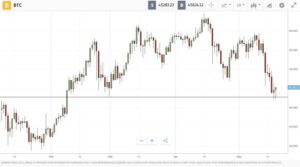HodlX Guest Post Submit Your Post
Bitcoin (BTC) is the most popular and volatile cryptocurrency. The pioneer of digital tokens has capitalized on its popularity to dominate the market. Essentially, there seems to be a 24/7 demand for Bitcoin, and according to sites that focus on providing Bitcoin predictions, the asset will not weaken anytime soon – just the opposite.
When Bitcoin is most volatile, its price moves significantly. This means that some traders potentially stand a chance to make huge profits.
ADVERTISEMENT
Now here is the big question.
When is Bitcoin most volatile?
The Forbes Digital Asset team conducted a study to determine when Bitcoin is most volatile. They examined price movement on four major crypto exchanges – Binance, Gemini, Coinbase, and Kraken – using proprietary data and analysis. Forbes examined more than 1.6 million data points over 24 months. For trading pairs, Forbes focused on the USD, Ethereum, and Tether as the primary base pairs.
According to the research results, the most volatile period was 16:00 UTC on a Wednesday. Forbes found that this time period was roughly 36% more volatile than the average of all time periods. This is the time when traders should have their eyes on the market.
The least volatile period was between 8:00 and 10:00 UTC on Monday, according to Forbes.
Note that these times represent the exact times when the Bitcoin market is least volatile and most volatile as indicated by the study. You should not confuse these times with the least volatile and most volatile days. According to the study, the most volatile day is Friday, while the least volatile day is Saturday.
Effect of BitMEX outflows
What could possibly be contributing to this insanely high Bitcoin price volatility? Well, numerous factors affect Bitcoin price movement. Expirations on BitMEX and the CME might cause additional volatility in the price of Bitcoin. For instance, BitMEX withdrawals occur at 13:00 UTC.
Additionally, both BitMEX and the CME expire on the last Friday of the contract month. BitMEX expires at noon UTC, and the expiry time for CME is 16:00 London Time (16:00 or 15:00 UTC depending on the observance of daylight savings time). The two windows can potentially add extra volatility, which supports Forbes’ observation that Friday records the highest volatility.
Least volatile time
The study claims that Bitcoin volatility is lowest on Monday between 8:00 and 10:00 UTC. There are no surprises here, as most people resume work at the start of the week. In fact, the research conducted by Forbes indicates that the volatility was 35% less than the average during this time. Again, no surprise. Perhaps what is more interesting is that Bitcoin volatility recorded at this time is less than the volatility recorded on the weekend.
Enter the whales
Now the big question is – what caused these changes in the market? The entry of big investors such as hedge funds using trading algorithms might have caused massive volatility on the weekends. While small investors also use algorithms, this likely does not cause a surge in the market like when large investors do it.
For instance, the crypto exchange platform Coinbase claims to have used advanced algorithms to assist MicroStrategy, a US software firm, in buying $425 million worth of Bitcoin. This technique can potentially cause huge volatility on weekends when the liquidity is thin. The volatility might be amplified further by manual traders.
Bitcoin does not rest on weekends
While the volatility is supposedly lower on Saturday, this does not mean you should disregard the weekends. For instance, on the first Saturday of the year (January 2nd), when people were still celebrating the new year, Bitcoin’s price was having the time of its life. The price soared 10% and breached $30,000 to hit a new all-time high.
This was one of several instances in which Bitcoin’s price surged on a public holiday or on a weekend to help the digital currency beat its previous highs. During the Christmas holiday, the spread between the bid and ask was quite broad, indicating thin liquidity. During this time, the volatility also proliferated.
ADVERTISEMENT
According to Reuters, between December and early January, Bitcoin experienced 10% higher trading volume on weekends than on weekdays across six cryptocurrency exchanges. This is a major shift from a year ago when weekends recorded 13% less volume than during conventional trading hours.
These changes have created challenges for market players. For example, investors are forced to adjust their office hours and risk management to avoid missing profitable opportunities.
Since Bitcoin operates 24/7, this causes strange swings toward unpredictable prices. Initially, the price was driven by retail traders. The entry of hedge funds might be causing volatility on weekends. In the last year, the price has increased almost tenfold.
The use of advanced technology to trade Bitcoin is also a factor that could cause an increase in volatility on weekends. The time-weighted average price is yet another method that is possibly causing unusual price movement. Ideally, this strategy allows traders to buy Bitcoin at a specific price, depending on the market volume.
Sometimes, Bitcoin trades hit the set volume on weekends. Therefore, manual traders are forced to wait on weekends to catch the massive price movement. This is because funds may look for volatility and trading opportunities when the liquidity is low.
Trading hours
Stock and foreign exchange (forex) trading hours also potentially provide a great time to trade cryptos. This is because the market volatility is highly correlated with the opening of the US market.
Remember, Bitcoin is based on US dollars. Additionally, most forex trading exchanges offer Bitcoin and other instruments as trading instruments. Therefore, dollar demand affects Bitcoin volatility. However, London and Asia stock trading sessions may have a smaller impact on Bitcoin than New York sessions do.
Bitcoin records an interesting trading period at around 16:00 UTC. For instance, according to Cointelegraph, investors traded an average volume of Bitcoin worth $6.5 million between 15:00 and 16:00 UTC over a 30-day period. On the opposite side of the scale, the market recorded the smallest average trading volume, $2 million, at 9:00 UTC over this period. This time corresponds to about two hours after the US markets open up for trading.
However, it is imperative to note that economic events and news can affect volatility. While you can’t predict the future price and volatility of BTC with total certainty, some price movements are predictable.
For instance, April volatility was possibly due to Tesla’s decision to stop accepting Bitcoin as a mode of payment. Similarly, the Chinese government’s action of cracking down on banks handling Bitcoin transactions might’ve exacerbated the situation. Nevertheless, the market was due for a correction, and many analysts stay positive when it comes to Bitcoin predictions.
ADVERTISEMENT
What causes the drastic Bitcoin volatility
Massive bull runs and drastic plummeting are quite common in the cryptocurrency market. While massive retracement is quite scary, it can provide huge trading opportunities for seasoned investors.
Numerous factors can cause the massive volatility in Bitcoin. First, the Bitcoin market takes place on a decentralized computer network. This means that the market operates 24/7. Unlike other assets, Bitcoin has no downtime. Therefore, investors can capitalize on price movement during the weekends or holidays.
Also, Bitcoin volatility is caused by limited supply. Currently, there is about 18.7 million Bitcoin in circulation out of the 21-million limit. Additionally, cryptocurrency is not regulated by the central bank. Instead, it derives value from a decentralized network. As a result, there is currently no financial institution or authority that can intervene in the Bitcoin market.
It is worth noting that Bitcoin volatility can have a massive effect on companies with substantial exposure to cryptocurrency. For instance, Tesla’s market value dipped 2.5% after the Bitcoin price plunge. Tesla has invested $1.5 billion in Bitcoin. Other companies that were affected include Coinbase and MicroStrategy.
Conclusion
Bitcoin is highly volatile. High volatility is a double-edged sword. This means that a trader can potentially rake in massive profits within a short time. However, a trader can lose massively if they are caught on the wrong side of the trade. Therefore, it is useful to know when the price is more likely to exhibit seismic movements.
Michael Kuchar is a foreign exchange and cryptocurrency trader and a blockchain enthusiast. He specializes in intraday trading of G20 currencies. To anticipate potential market moves, he utilizes a fusion of both fundamental and technical analysis. Michael is the founder of the trading educational website TradingBeasts and also writes for CoinSpeaker, FX Empire, Equities, DailyForex and TalkMarkets.
Follow Us on Twitter Facebook Telegram

Disclaimer: Opinions expressed at The Daily Hodl are not investment advice. Investors should do their due diligence before making any high-risk investments in Bitcoin, cryptocurrency or digital assets. Please be advised that your transfers and trades are at your own risk, and any loses you may incur are your responsibility. The Daily Hodl does not recommend the buying or selling of any cryptocurrencies or digital assets, nor is The Daily Hodl an investment advisor. Please note that The Daily Hodl participates in affiliate marketing.
Featured Image: Shutterstock/Bruce Rolff
- 000
- 7
- 9
- Action
- Additional
- Advanced Technology
- advice
- advisor
- Affiliate
- affiliate marketing
- algorithms
- All
- analysis
- April
- around
- asia
- asset
- Assets
- authority
- auto
- Bank
- Banks
- Billion
- binance
- Bitcoin
- Bitcoin BTC
- Bitcoin Price
- bitcoin transactions
- Bitcoin volatility
- BitMEX
- blockchain
- BTC
- buy
- buy bitcoin
- Buying
- Catch
- caught
- Cause
- caused
- Central Bank
- chinese
- Christmas
- claims
- CME
- coinbase
- Common
- Companies
- contract
- crypto
- crypto exchange
- Crypto Exchanges
- crypto trading
- cryptocurrencies
- cryptocurrency
- Cryptocurrency Exchanges
- cryptocurrency market
- currencies
- Currency
- data
- day
- daylight
- decentralized
- Demand
- digital
- Digital Asset
- Digital Assets
- digital currency
- Dollar
- dollars
- downtime
- driven
- Early
- Economic
- educational
- ethereum
- events
- exchange
- Exchanges
- financial
- Firm
- First
- Focus
- Forbes
- foreign exchange
- forex
- Forex Trading
- founder
- Friday
- funds
- future
- FX
- G20
- Gemini
- great
- Guest
- Handling
- Headlines
- Hedge Funds
- here
- High
- HODL
- holidays
- HTTPS
- huge
- image
- Impact
- Increase
- industry
- Institution
- investment
- Investments
- Investors
- IT
- Kraken
- large
- latest
- Limited
- Liquidity
- London
- major
- Making
- management
- Market
- Marketing
- Markets
- MicroStrategy
- million
- Monday
- months
- Most Popular
- moves
- network
- new year
- New York
- news
- offer
- open
- Opinions
- opportunities
- Other
- payment
- People
- platform
- Popular
- Predictions
- price
- public
- records
- research
- REST
- Results
- retail
- Reuters
- Risk
- risk management
- Scale
- set
- shift
- Short
- Sites
- SIX
- small
- Software
- specializes
- spread
- square
- start
- stay
- stock
- stock trading
- Strategy
- Study
- supply
- Supports
- surge
- surprise
- Technical
- Technical Analysis
- Technology
- Tesla
- Tether
- The Daily Hodl
- The Future
- time
- Tokens
- trade
- Trade Cryptos
- trader
- Traders
- trades
- Trading
- Transactions
- us
- USD
- value
- Volatility
- volume
- wait
- Website
- week
- weekend
- What is
- windows
- within
- Work
- worth
- year












